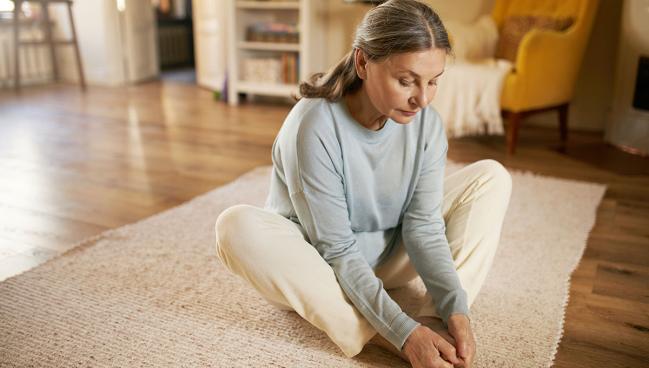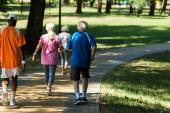Simple Sitting-Rising Test Linked to Natural and CV Mortality
The test of nonaerobic functioning may raise awareness that people need to work on balance and flexibility as they age.

The ability to lower yourself to the floor and get back up without using your hands may be a risk predictor for natural and cardiovascular mortality, Brazilian researchers say.
Middle-aged and older adults who scored poorly on the sitting-rising test (SRT) had a 3.8-fold higher risk of death from natural causes and a sixfold higher risk of death from CV causes over 12 years of follow-up compared with those who got the highest score. The test, which scores the individual from 0 to 10 (5 points max for sitting and 5 for rising), deducts points for using your hands, forearm, knee, or holding onto a support to descend to or ascend from a seated position on the ground, as well as for unsteady execution.
“It’s common sense that aerobic fitness is important for survival, but we [have to] start to look that other things related to fitness that are also important,” said Claudio Gil Araújo, MD, PhD (CLINIMEX, Rio de Janeiro, Brazil), lead author of the study and the developer of the non-aerobic SRT.
To TCTMD, Araújo said the connection between the test and mortality risk is likely related to flexibility and balance, which may influence other things that feed into CV health like exercise ability and self-care. For those who do poorly on the test, it may point them and their clinicians toward actions that could improve healthy aging like losing weight, improving muscle strength and coordination, and working on flexibility and balance issues.
Age shouldn’t be a factor in ability to perform the test, said Araújo, noting that his group has assisted those as old as 95 to start slowly and do it safely, and they have seen people of all ages improve their scores. It is also easily applied in children and adolescents.
When used alongside other standardized vitals like blood pressure, heart rate, and weight, Araújo and colleagues say the test can add information that can’t be gathered in other ways, potentially tipping physicians off to patients they should focus more attention on.
“If someone gets a zero on the test, they cannot get down or up on their own, we become more concerned about risk factors and start trying to explore what can we do to help them. . . . And maybe I’m more aggressive with some aspects of risk factor control than I would be [with a patient] who performs very well on the test,” Araújo added.
Commenting for TCTMD, Prashant Rao, MD (Beth Israel Deaconess Medical Center, Boston, MA), said the study highlights the importance of functional measurements in CV health assessment and prevention efforts.
“I think physicians intuitively know that certain patients would do poorly on this test, but to show that this type of poor functioning is clearly linked to future survival is an important contribution,” he said. “One thing I quite like about the score is that there's no real sex difference because while men might have more strength, women make up for this in terms of greater flexibility. So, the total score kind of evens itself out, making it a generalizable tool.”
Higher Survival With Better Scores
Published June 18, 2025, in the European Journal of Preventive Cardiology, the study included 4,282 volunteers (mean age 59 years; 32% women) who had performed the SRT as part of a medical-functional evaluation in a private clinic supervised by a small group of physicians experienced in the protocol.
Over the 12.3-year follow-up, 15.5% of patients died. Risk of death was 3.7% for those who achieved a perfect score of 10 on the SRT compared with 7% for scores of 8.5-9.5, 11.1% for a score of 8, 20.4% for scores of 4.5-7.5, and 42.1% for scores of 0 to 4, a category in which volunteers needed significant assistance and/or displayed significant instability.
Among those with a perfect score of 10, no women and three men died from natural causes in the first 4 years of follow-up. By 10 years, survival rates were 97% for men and women with a score of 10, 88% for those with a score of 8, and 73% for a score of 0-4.
In secondary analyses, scores less than 8 were associated with greater mortality than those of 8 or higher (P < 0.001), with similar trends seen for natural and CV mortality.
Araújo said while he doesn’t view the test itself as something that people necessarily need to practice, for those with mid-range results it may serve as encouragement for working on balance, strength, and flexibility.
“This is not a self test or an exercise, it’s a screening tool [to be used] in a supervised environment, although anyone who is trained in the protocol can supervise and score it,” he added.
For participants with long-term follow-up, the ability to repeatedly achieve a good score over time has been observed even among those who have had bypass surgery and other major health issues, which Araújo believes is reassuring for clinicians and patients alike that they are maintaining a level of functioning important to their survival. One important goal for future work, Araújo and colleagues say, is to understand if exercise training-induced SRT score improvement conveys any survival advantages.
To TCTMD, Rao said the results make sense because the SRT combines multiple aspects of functional wellness that have been shown individually to be associated with survival. That being said, it may not be simple or practical to implement this test widely into practice, he commented.
“When you think about all the pressures we have in clinic, you've got a very set limit of time to see and evaluate patients, . . . so I think there are challenges to implementing this in every patient and every prevention clinic at this moment in time,” Rao noted. “[But] it's these other nontraditional risk factors that we really need to look at in order to improve cardiovascular mortality in the long term, so I certainly commend the authors for identifying this marker.”
L.A. McKeown is a Senior Medical Journalist for TCTMD, the Section Editor of CV Team Forum, and Senior Medical…
Read Full BioSources
Araújo CGS, de Souza e Silva CG, Myers J, et al. Sitting–rising test scores predict natural and cardiovascular causes of deaths in middle-aged and older men and women. European Journal of Preventive Cardiology. 2025;Epub ahead of print.
Disclosures
- Araújo and Rao report no relevant conflicts of interest.






Comments